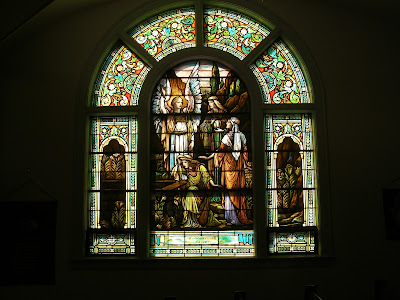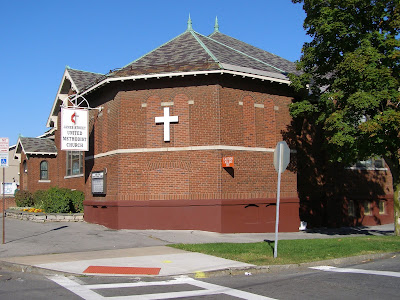 |
| Syracuse, NY. The Julius Hunziker House on Robineau Road. Ward Wellington Ward, architect, 1926. Photo: Samuel D. Gruber 2017. |
 |
| Syracuse, NY. The Julius Hunziker House on Robineau Road. Ward Wellington Ward, architect, 1926. Replacement fireplace. Photo: Samuel D. Gruber 2017. |
 |
| Syracuse, NY. The Julius Hunziker House on Robineau Road. Ward Wellington Ward, architect, 1926. Original living room fireplace revealed. Photo: Samuel D. Gruber 2017. |
 |
| Syracuse, NY. The Julius Hunziker House on Robineau Road. Hunziger family around fireplace. Photo: courtesy of Cleota Reed |
by Samuel D. Gruber
Earlier this month I joined some members of the Arts & Crafts Society of Central New York and Strathmore neighbors at the "new" home of Michael Matthews and Jane Crow. The house was really built in 1926 for the real estate salesman Julius Hunziker and his family, who lived there until 1932. Designed by noted local Arts & Crafts architect Ward Wellington Ward, it was the last of his several houses built in the neighborhood from the time the Strathmore subdivision opened in 1919. It was also one of Ward's very last projects overall, as he died in 1926, the year the house was completed.
Michael and Jane recently purchased the house and are now fixing it up before moving in. Most of the original features are intact. The overall style and detailing mixes elements of the then-popular Colonial Revival style, as can be seen in the stairway and in many of the moldings, but with Ward's English-inspired Arts and Crafts approach to design in the arrangement of the rooms, the window, and the built-in cabinets - all of which were design components he had perfected before World War I.
The new owners were perplexed, however, by the fireplace. The shiny slabs of black marble surrounding the fireplace were clearly later additions, and it was known that the mantle, too, was a replacement, though apparently modeled on the original. In discussions with Arts and Crafts Society members over lunch at the Annual meeting which Jane and Michael attended, it was unanimously agreed that the original fireplace would have had Moravian tile decoration, as did all Ward's fireplaces. We wondered if the original was intact beneath the black marble.
According to Cleota Reed, expert on both Ward and Henry Mercer and the Moravian Pottery and Tiles Works of Doylestown, PA, thousands of fireplaces across the country were made using Mercer (or Moravian) tiles. No architect. however, built more fireplaces with more than Ward Wellington Ward. There were hundreds of tile types and thousands of combinations.
Michael was curious, and so moved the wooden mantelpiece, and poked around the fireplace, and with little effort was able to pry off one of the marble slabs. Behold! The original fireplace decoration was there and still in good condition. So Michael and Jane invited people over to witness the unveiling, and with eyes wide we watched as two more panels fell away to reveal a complete series of twelve tile zodiac designs spaced on the sides and above the fireplace. In the center was a tile of a sailing ship, a popular emblem of the Arts and Crafts Movement and a favorite of Ward Wellington Ward.
 |
| Syracuse, NY. The Julius Hunziker House on Robineau Road. Ward Wellington Ward, architect, 1926. Original fireplace tiles. Sailing ship. Photo: Samuel D. Gruber 2017 |
There were probably plain or a pattern of colored tiles on the floor in front of the fireplace, too, but these must have been dug out and removed to lay the black slab there now, flush with the floor.
 |
| Syracuse, NY. Julius Hunziker House on Robineau Road. Ward Wellington Ward, architect, 1926. Original fireplace tiles. Aquarius. Photo: Samuel D. Gruber 2017 |
 |
| Syracuse, NY. Julius Hunziker House on Robineau Road. Ward Wellington Ward, architect, 1926. Original fireplace tiles. Pisces. Photo: Samuel D. Gruber 2017 |
 |
| Syracuse, NY. Julius Hunziker House on Robineau Road. Ward Wellington Ward, architect, 1926. Original fireplace tiles. Ares. Photo: Samuel D. Gruber 2017 |
 |
| Syracuse, NY. Julius Hunziker House on Robineau Road. Ward Wellington Ward, architect, 1926. Original fireplace tiles. Taurus. Photo: Samuel D. Gruber 2017 |
 |
| Syracuse, NY. Julius Hunziker House on Robineau Road. Ward Wellington Ward, architect, 1926. Original fireplace tiles. Gemini. Photo: Samuel D. Gruber 2017 |
 |
| Syracuse, NY. Julius Hunziker House on Robineau Road. Ward Wellington Ward, architect, 1926. Original fireplace tiles. Cancer. Photo: Samuel D. Gruber 2017 |
 |
| Syracuse, NY. Julius Hunziker House on Robineau Road. Ward Wellington Ward, architect, 1926. Original fireplace tiles. Leo. Photo: Samuel D. Gruber 2017 |
 |
| Syracuse, NY. Julius Hunziker House on Robineau Road. Ward Wellington Ward, architect, 1926. Original fireplace tiles. Virgo. Photo: Samuel D. Gruber 2017 |
 |
| Syracuse, NY. Julius Hunziker House on Robineau Road. Ward Wellington Ward, architect, 1926. Original fireplace tiles. Libra. Photo: Samuel D. Gruber 2017 |
 |
| Syracuse, NY. Julius Hunziker House on Robineau Road. Ward Wellington Ward, architect, 1926. Original fireplace tiles. Scorpio. Photo: Samuel D. Gruber 2017 |
 |
| Syracuse, NY. Julius Hunziker House on Robineau Road. Ward Wellington Ward, architect, 1926. Original fireplace tiles. Sagittarius. Photo: Samuel D. Gruber 2017 |
 |
| Syracuse, NY. Julius Hunziker House on Robineau Road. Ward Wellington Ward, architect, 1926. Original fireplace tiles. Capricorn. Photo: Samuel D. Gruber 2017 |
 |
| Arts & Crafts Society board member Bill Bowen focuses in on the newly revealed tiles. Photo: Samuel D. Gruber 2017 |
 |
| Syracuse, NY. Julius Hunziker House on Robineau Road. Ward Wellington Ward, architect, 1926. Original fireplace tiles. Photo: Samuel D. Gruber 2017 |
 |
| Syracuse, NY. Julius Hunziker House. Ward Wellington Ward, architect, 1926. Living room windows looking out onto Robineau Road.. Photo: Samuel D. Gruber 2017 |
 |
| Syracuse, NY. Julius Hunziker House. Ward Wellington Ward, architect, 1926. Stairway Photo: Samuel D. Gruber 2017 |
 |
| Syracuse, NY. Julius Hunziker House. Ward Wellington Ward, architect, 1926. Door between foyer and front stair hall. Photo: Samuel D. Gruber 2017 |
To learn more about Henry Mercer and the Moravian Pottery and Tile Works the must read book is Cleota Reed, Henry Chapman Mercer and the Moravian Pottery and Tile Works (Philadelphia: Univ. of Pennsylvania Press, 1987).
For more on Ward Wellington Ward search this blog.




































.JPG)





